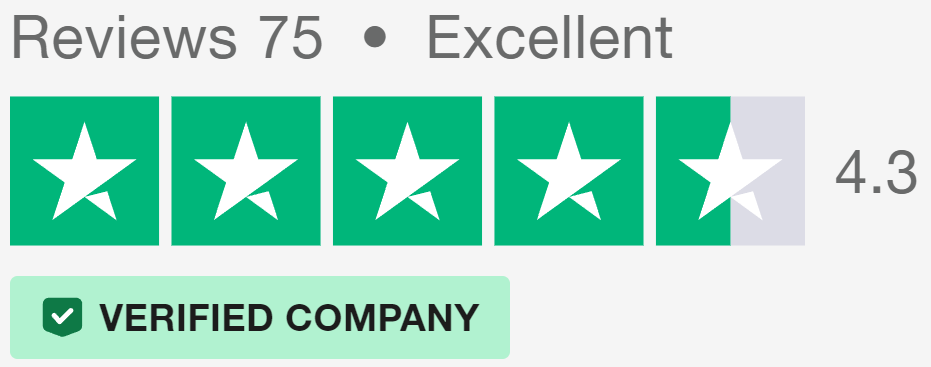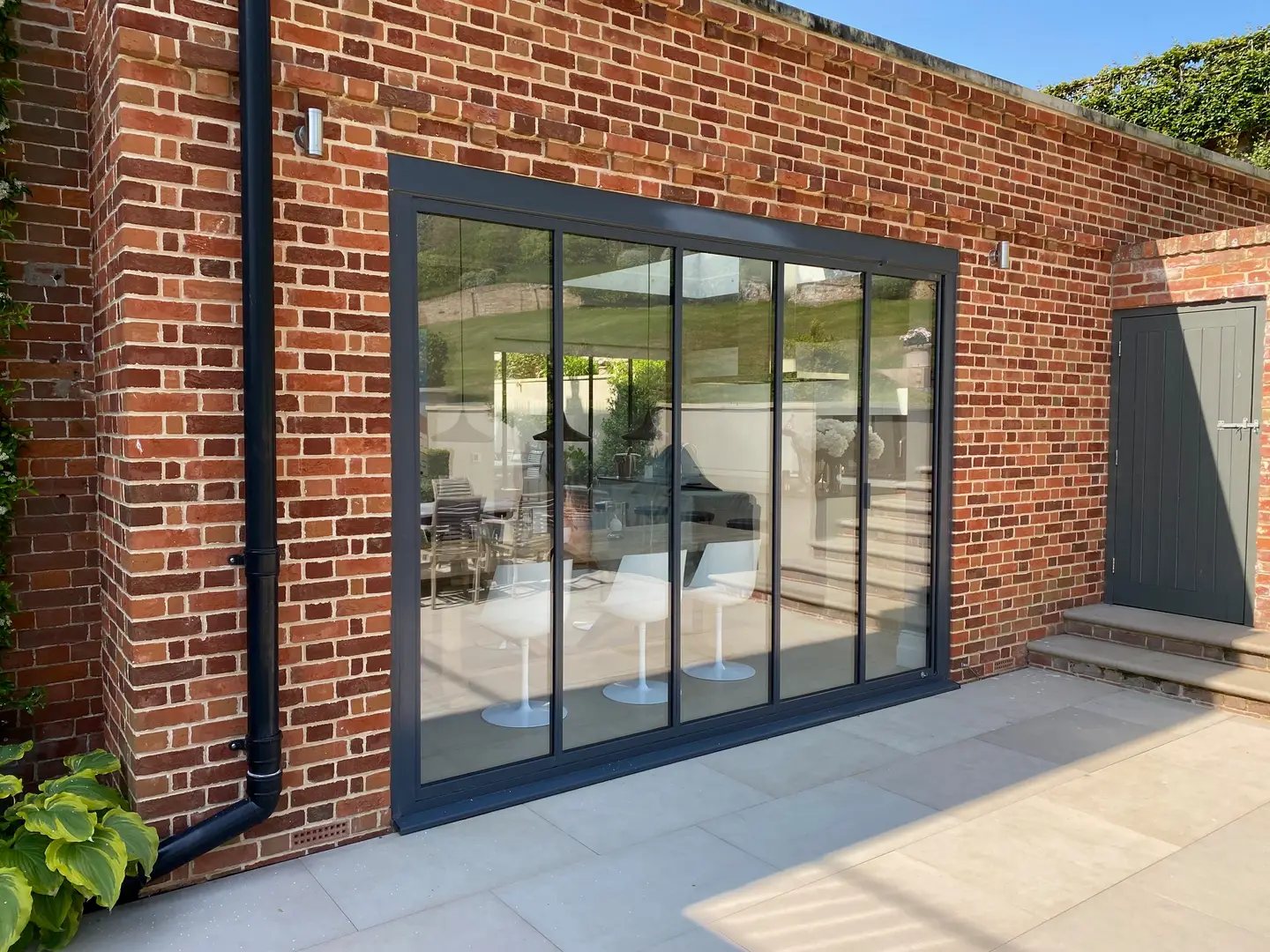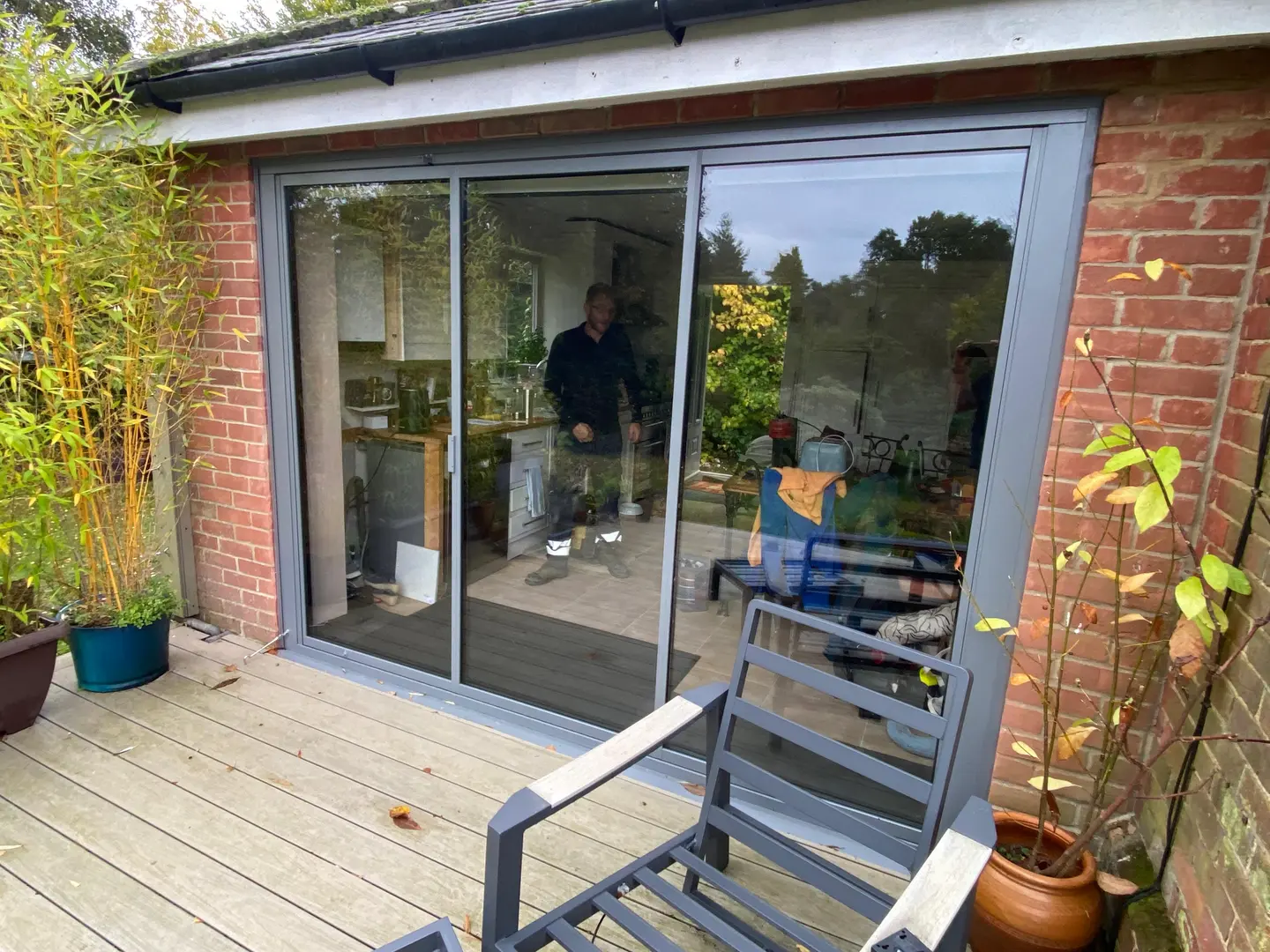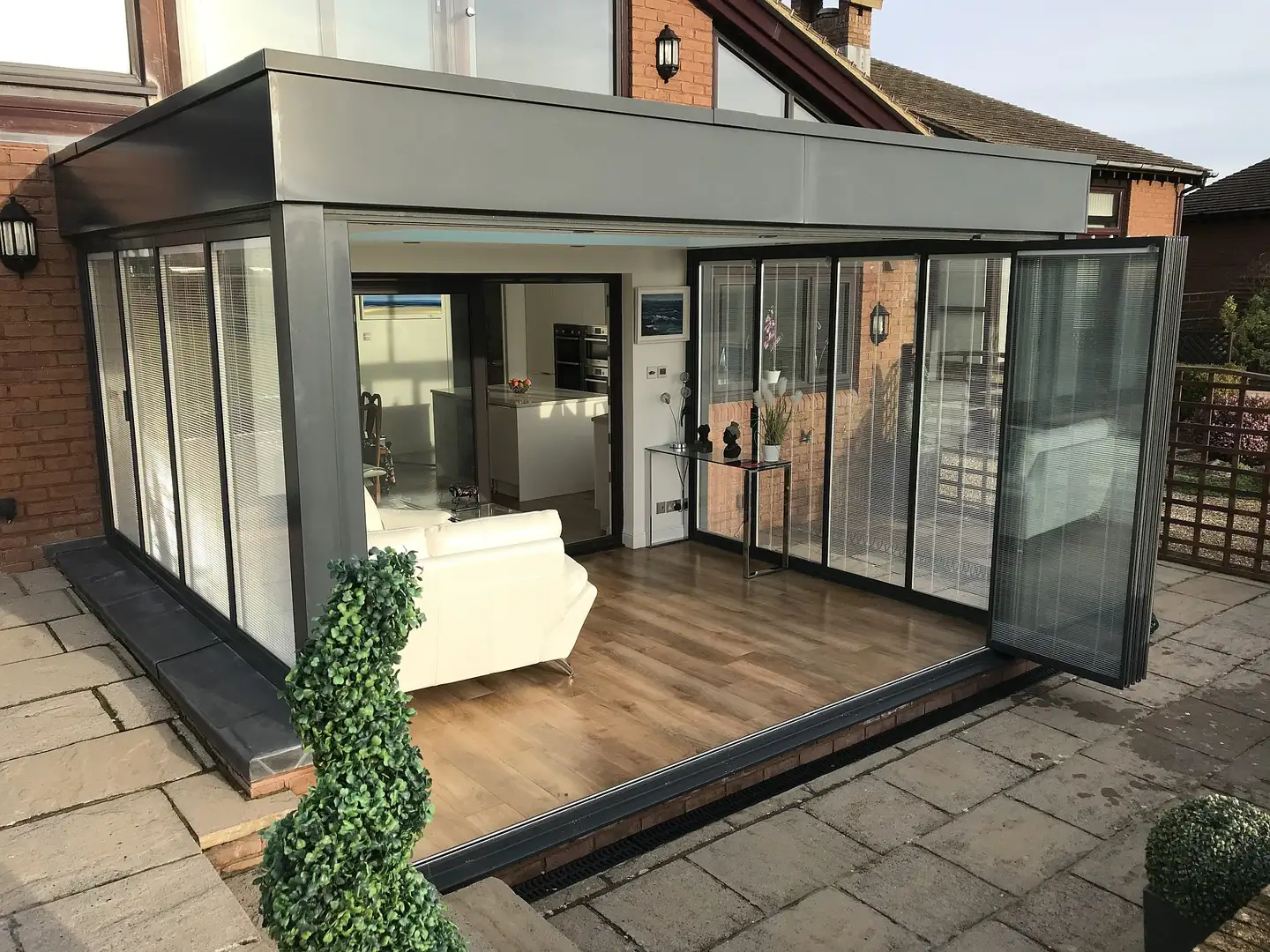Grey Glass Doors Guide: Options, Types & Styling
Table of Contents

Different Types of Grey Glass Door Systems
Glass doors finished in grey have risen to prominence in British architecture, with manufacturers responding to growing demand by offering more styles and configurations than ever before.
Sliding Grey Glass Door Features
Modern sliding doors in grey bring a streamlined look to spaces both large and modest. The panels glide smoothly along robust aluminium tracks, with multi-panel designs allowing for wider openings when needed. Single-track systems suit smaller spaces like kitchen extensions, while double and triple tracks let you stack multiple grey glass doors to one side.
Running from floor to ceiling, sliding panels in grey create clean sight lines that work particularly well in contemporary builds. The frames can be powder-coated in any grey shade, from light silver to deep graphite, letting you match existing windows or create striking contrasts with your walls.

Grey Bifold Door Configurations
Grey bifold doors fold back accordion-style, stacking neatly against walls to open up entire facades. The concertina design means you can partially open just a few panels for ventilation or fold back the entire set to merge indoor and garden spaces. Frame depths vary between manufacturers, with slimmer profiles giving a more refined appearance.
Slide and Turn Grey Door Systems
Unlike standard bifolds, slide and turn doors let each panel move independently along the track before pivoting open. The panels of these grey glass doors stack perpendicular to the frame rather than folding, which can save space in certain layouts. This flexibility makes them ideal for curved walls or corner installations where traditional folding mechanisms might be impractical.
Grey Glass Door Placement and Layout
The position and configuration of grey glass doors play a vital part in determining how well they serve your space.
Corner Configurations
L-shaped layouts offer exciting possibilities for grey glass doors, especially in modern interiors where traditional walls might limit the connection to outdoor spaces. Corner bifolds open from the centre outwards, letting you remove the barrier between two adjacent walls. When specifying corner units, the meeting point demands careful planning – manufacturers use specially designed posts that provide support while maintaining slim sightlines.
Grey framed glass doors work particularly well in corner positions because their neutral tone draws attention to the views beyond rather than the frames themselves. The junction between panels needs precise design to ensure proper operation, with robust hinges supporting the extra weight at the corner point.
Many properties feature unusual angles or bay windows that standard door configurations struggle to accommodate. In these cases, made-to-measure grey glass doors can follow the building’s lines while maintaining proper operation. Special corner posts allow panels to turn smoothly through non-standard angles, though this often requires longer lead times during manufacture.
Room Divider Applications
Grey glass interior doors have found a new purpose as flexible room dividers, particularly in open-plan spaces that sometimes need separation. Double-track sliding systems let you partition areas temporarily – perfect for home offices or dining rooms that serve multiple purposes throughout the day.
Modern aesthetic choices often favour grey glass when dividing interior spaces because it maintains visual connections while providing acoustic benefits. Frosted or sandblasted panels offer privacy without blocking light, while clear glass with grey frames provides subtle definition between zones.
Sound Control Features
Laminated acoustic glass reduces noise transfer between divided spaces. Multiple layers of glass bonded together with special interlayers can cut sound transmission, making grey glass doors practical for music rooms or home cinemas.
Statement Entrance Ideas
Contemporary designs increasingly feature grey glass doors as main entrances, moving away from traditional solid doors. Pivot systems on central spindles create grand openings, with panels rotating smoothly on precision-engineered mechanisms. The visual weight of grey frames helps these installations feel substantial and secure while maintaining a modern appearance.
Large-format grey glass doors make particularly striking entrances for garden rooms or pool houses. Oversized panels, sometimes reaching three metres in height, create impressive thresholds. However, size limits vary between systems – wider panels generally need thicker frames to maintain stability.
When used as primary entrances, grey glass doors often incorporate advanced security features. Multi-point locking systems, toughened safety glass, and reinforced frames provide protection without compromising the clean lines that make these installations so appealing.
The popularity of grey glass doors in entrance settings stems partly from their ability to suit varied architectural styles. Whether installed in period properties or ultra-modern builds, grey tones complement brick, stone, and rendered finishes. Darker anthracite shades often work well with traditional materials, while lighter greys suit contemporary cement and metal cladding.
The Grey Spectrum in Grey Glass Doors
Selecting the right shade of grey for glass doors requires careful attention to light conditions and surrounding materials.

Light vs Dark Grey Options
Powder coated aluminium doors come in an extensive range of grey tones, from pale silvers through to deep charcoals. Lighter greys like ash grey create an airy feel in smaller living spaces, while darker anthracite finishes make bold architectural statements. North-facing rooms often benefit from paler shades that reflect more light, whereas south-facing installations can handle deeper tones without appearing gloomy.
Morning and evening light changes how grey glass doors appear throughout the day. Some manufacturers provide sample panels that you can test in different positions and lighting conditions. The angle of sunlight can make certain grey finishes appear warmer or cooler, so it’s worth observing samples at different times before committing to a specific shade.
Grey framed glass doors need to coordinate with existing windows and other exterior elements. Most suppliers offer RAL colour matching to ensure consistency across different components. However, slight variations can occur between different materials and manufacturing processes, making it essential to check samples against existing grey finishes.
Two-Tone Grey Combinations
Mixing different grey tones within the same installation creates subtle depth and interest. Darker outer frames paired with lighter sash sections draw attention to the glass while maintaining a cohesive design style. Some systems allow for different finishes on interior and exterior surfaces, letting you coordinate with separate colour schemes on each side.
Modern manufacturers have developed sophisticated dual-colour coating processes that maintain crisp lines between different grey shades. The precision of these techniques means there’s no bleeding or overlap between colours, even on complex corner joints and meeting stiles.
Metallic and Special Finishes
Beyond standard grey finish options, metallic coatings add subtle shimmer and depth to glass door frames. These specialised surfaces contain tiny metallic particles that catch the light differently as you move around them. Unlike regular paint finishes, metallic coatings can help disguise minor scratches and wear marks.
Textured grey surfaces provide practical benefits beyond pure aesthetics. Manufacturers have developed micro-textured finishes that resist fingerprints and smudges while maintaining a smooth feel. These specialised coatings use advanced powder coating techniques to create surfaces that need less frequent cleaning.
Surface Durability
Premium grey glass doors use multi-stage coating processes to ensure long-lasting colour stability. UV-resistant pigments and protective clear coats prevent fading, even in direct sunlight. The best systems undergo rigorous testing in accelerated weathering chambers to simulate years of exposure to British weather conditions.
Some manufacturers now offer self-cleaning grey coatings that use photocatalytic properties to break down dirt and organic matter. When exposed to UV light, these surfaces actively repel water and prevent dirt from sticking, though they typically command a premium price point.
The latest developments in grey finishes include thermochromic coatings that respond to temperature changes. These innovative surfaces subtly shift tone in different conditions, though their practical applications remain limited to specific architectural projects where this feature adds genuine value.
Smart Design Details for Grey Glass Doors
Frame profiles and hardware choices determine how grey glass doors look and perform in daily use.
Frame Profiles and Sightlines
External bifold doors showcase major advances in frame design, with modern systems achieving impressive glass-to-frame ratios. Slim profiles now measure as little as 70mm in width, while still providing robust support for large glass panels. These narrower frames let more light into your home and create cleaner views to the outside.
Grey framed glass doors benefit particularly from recent improvements in thermal break technology. Advanced polyamide bars between internal and external frame sections prevent cold bridging without increasing visible frame width. Some manufacturers now use foam-filled thermal breaks that improve insulation while maintaining slim profiles.
The way frames join together at panel meeting points needs special attention. Panel alignment becomes especially important with darker grey finishes, where any misalignment shows more clearly than with lighter colours.
Handle and Hardware Matching
Grey patio doors offer numerous hardware options beyond basic handles. Magnetic catches help hold panels in place when open, while soft-close mechanisms prevent slamming. Premium systems include multi-point locking with discrete key cylinders that sit flush with the frame surface.
Handle designs range from minimal finger pulls to substantial lever sets. Brushed stainless steel or anodised aluminium finishes complement grey frames particularly well. Some manufacturers offer handle sets colour-matched to frame finishes, creating a coordinated appearance across all door components.
Modern locking systems integrate smoothly into grey door frames without disrupting clean lines. Electronic locks can link to home automation systems, with status sensors providing security monitoring. Premium hardware uses marine-grade stainless steel components to prevent corrosion, even in coastal locations.
Glass Types and Tints
The glass itself plays a major part in how grey glass doors perform. Solar control coatings reduce heat gain while maintaining clear views, with some versions adding a subtle grey tint that coordinates with frame colours. Advanced glazing units combine multiple glass types to balance thermal performance, security, and aesthetics.
Gradient tinting offers interesting design possibilities, with glass transitioning from clear to grey from top to bottom. This technique works especially well in tall installations where privacy needs vary between eye level and upper sections. Some manufacturers can create custom gradient patterns, though these specialised options typically involve longer lead times.
Privacy glass options have expanded beyond traditional acid-etched finishes. Digital ceramic printing allows for precise patterns in grey tones, while switchable glass changes from clear to opaque at the touch of a button. These advanced options cost more than standard glazing but provide unique benefits in specific situations.
The latest glass technology includes photochromic panes that darken automatically in bright sunlight. While these self-tinting systems work well in some commercial applications, their slower response times and higher costs currently limit residential use. Anti-reflective coatings reduce glare without darkening the glass, though they require more frequent cleaning to maintain their effectiveness.
Laminated acoustic glass helps reduce noise transmission through grey glass doors. Multiple glass layers bonded with special interlayers cut sound transfer while maintaining clarity. Some systems achieve impressive sound reduction without requiring overly thick glass units, though performance varies between manufacturers.
Styling Around Grey Glass Doors
Well-chosen surroundings make grey glass doors shine in any setting, whether modern or traditional.

Colour Schemes That Work
Paint colours near grey glass doors need careful selection to avoid clashing undertones. Warm whites and soft creams work beautifully with warmer grey finishes, while pure brilliant white pairs well with cooler tones. Deep navy or forest green walls create striking contrasts with lighter grey frames, drawing attention to architectural features.
Anthracite grey has become particularly popular for exterior frames, pairing naturally with pale rendered walls or exposed brickwork. This deep, rich shade stands out against lighter surfaces while maintaining a sophisticated appearance. The key lies in matching undertones – some anthracite finishes lean slightly blue, while others have brown undertones that need accounting for in your colour choices.
Natural materials often complement grey framed glass doors particularly well. Oak flooring adds warmth through its rich grain patterns, while concrete screed provides an industrial edge that works with modern frame designs. Stone tiles in slate or limestone create coherent connections between indoor and garden spaces.
Metal finishes near grey doors deserve special attention. Brushed brass or copper hardware can warm up cooler grey tones, while chrome and stainless steel maintain a contemporary feel. Even small details like socket plates and light switches contribute to the overall look – premium manufacturers now offer electrical accessories in exact frame colour matches.
Flooring Transitions
Level thresholds between different flooring materials demand precise planning when installing grey doors. Matching floor heights helps create smooth passages between spaces while protecting door mechanisms from excess wear. Some systems include adjustable threshold sections that accommodate slight variations in floor levels.
Drainage channels become essential with exterior grey glass doors in British weather. Linear drains with discrete covers prevent water ingress without creating obvious breaks in flooring designs. Premium systems use powder-coated drain covers matched to door frames for visual consistency.
Wood-effect porcelain tiles offer practical alternatives to timber near grey doors, providing water resistance while maintaining natural appearances. Their reduced thickness compared to real wood helps achieve level thresholds without excessive floor build-up heights. Modern printing techniques create incredibly realistic grain patterns that complement grey door frames.
We’d Love to Help You
Vision Glass Doors is a designer, manufacturer, and installer of premium door systems. We are a family run business with over 20 years’ experience and 5,000 installations across the UK.
Our leading range of door systems include Ultra Slim – Slide and Turn Doors, Slimline Sliding Patio Doors and Frameless Glass Doors. Suitable for various internal and external applications, they are applicable to residential and commercial projects.
Click Quick Quote Online for a free quotation within 24 hours. Alternatively, call or email us on 01582 492730 or at info@visionglassdoors.co.uk.

